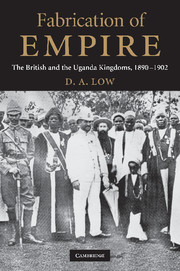Book contents
- Frontmatter
- Contents
- Preface
- List of abbreviations and locations
- Sketch maps
- 1 Prologue: survey and agenda
- 2 Statecraft: external intrusion and local dominion
- 3 Ferment: conversion and revolution in Buganda
- 4 Upcountry: might-have-beens and the Buganda/Uganda outcome
- 5 Warbands: new military formations and ground level imperialism
- 6 Paramountcy: Toro, Busoga and the new overlords
- 7 Defeat: Kabalega's resistance, Mwanga's revolt and the Sudanese mutiny
- 8 Succession: Nkore and the war of Igumira's eye
- 9 Dénouement: aggregations and rulerships
- 10 Government: colonial settlements and the Buganda model
- 11 Capstone: honour, awe and imperialism
- 12 Round up and review
- Select bibliography
- Index
9 - Dénouement: aggregations and rulerships
Published online by Cambridge University Press: 04 July 2009
- Frontmatter
- Contents
- Preface
- List of abbreviations and locations
- Sketch maps
- 1 Prologue: survey and agenda
- 2 Statecraft: external intrusion and local dominion
- 3 Ferment: conversion and revolution in Buganda
- 4 Upcountry: might-have-beens and the Buganda/Uganda outcome
- 5 Warbands: new military formations and ground level imperialism
- 6 Paramountcy: Toro, Busoga and the new overlords
- 7 Defeat: Kabalega's resistance, Mwanga's revolt and the Sudanese mutiny
- 8 Succession: Nkore and the war of Igumira's eye
- 9 Dénouement: aggregations and rulerships
- 10 Government: colonial settlements and the Buganda model
- 11 Capstone: honour, awe and imperialism
- 12 Round up and review
- Select bibliography
- Index
Summary
By the late 1890s there were many indications that the British had fastened their colonial hegemony on the great majority of the northern lakes kingdoms. As earlier chapters have variously emphasised, that to a large degree had been accomplished because they commanded far greater coercive power than any who sought to resist them. Under the aegis of a relatively tiny succession of British military officers, they were able to bring to the region sufficient externally recruited mercenary troops to comprise the core of the often much larger local forces available to them. Their formidable armoury of rifles and Maxim and Hotchkiss guns was much more lethal than any held by those who might be minded to confront them. The professional military training of their officers and the discipline they imposed upon their soldiery were similarly unmatched, while the array of forts they built at key points across the countryside not only testified to their determination to impose their dominion upon the region, but provided them with secure footholds from which it proved all but impossible to dislodge them. All of which made them the most formidable power in the region. In the event, actual military force, which could be brutally lethal when it was used, was not invariably employed. The threat that it might be, however, served to deter a great many who might otherwise have sought to withstand them.
- Type
- Chapter
- Information
- Fabrication of EmpireThe British and the Uganda Kingdoms, 1890–1902, pp. 249 - 280Publisher: Cambridge University PressPrint publication year: 2009



